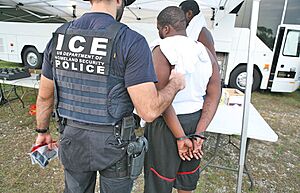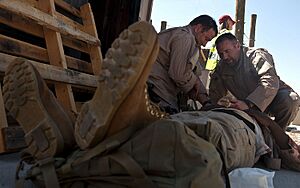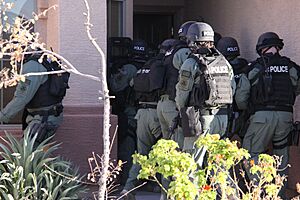U.S. Immigration and Customs Enforcement facts for kids
Quick facts for kids U.S. Immigration and Customs Enforcement |
|
|---|---|

ICE logo
|
|

HSI Special Agent badge
|
|

ERO Officer badge
|
|
| Motto | "Protecting National Security and Upholding Public Safety" HSI's motto: Honor, Service, Integrity |
| Agency overview | |
| Formed | March 1, 2003 |
| Preceding agency |
|
| Employees | 20,000+ (2016) |
| Annual budget | $7.6 billion (FY 2018) |
| Jurisdictional structure | |
| Operations jurisdiction | United States |
| Specialist jurisdictions |
|
| Operational structure | |
| Headquarters | 500 12th Street SW Washington, D.C., U.S. |
| Agency executives |
|
| Parent agency | United States Department of Homeland Security |
U.S. Immigration and Customs Enforcement (ICE) is a federal law enforcement agency in the U.S. Department of Homeland Security. ICE's main job is to protect the United States. They work to stop crime across borders and prevent illegal immigration. These actions help keep the country safe.
ICE carries out its mission by enforcing over 500 federal laws. They focus on stopping customs violations and enforcing immigration rules. They also work to prevent terrorism and fight the illegal movement of people and goods. ICE has two main parts: Homeland Security Investigations (HSI) and Enforcement and Removal Operations (ERO). There are also three support divisions that help them.
Enforcement and Removal Operations (ERO) mainly handles the deportation of people who are in the U.S. illegally. This is one of ICE's most visible jobs. ERO also manages facilities where these people are held. In cities, ERO officers often focus on finding people involved in serious crimes. For example, in 2020, most people arrested by ERO had criminal records. At the border, ERO officers take in and hold people caught by the United States Border Patrol.
ICE has offices all over the United States. They also have staff in many U.S. embassies in other countries. ICE staff do not patrol U.S. borders; that is the job of the Border Patrol. HSI and ERO work as separate law enforcement groups. HSI stops international crime, while ERO handles finding, holding, and removing people who are in the country illegally.
Contents
History of ICE

U.S. Immigration and Customs Enforcement was created after the September 11, 2001, attacks. It was formed under the Homeland Security Act of 2002. When the Department of Homeland Security was made, many border and law enforcement groups were combined. ICE became the largest investigative part of this new department. It also helps the FBI with its Joint Terrorism Task Force.
Some of the groups that joined ICE included parts of the United States Customs Service. Also, the crime investigation and deportation parts of the Immigration and Naturalization Service became part of ICE. The Federal Protective Service was also part of ICE for a while. The history of HSI Special Agents goes back to the U.S. Customs Service, which started in 1789.
How ICE is Organized
U.S. Immigration and Customs Enforcement works to find and fix weak spots in border, economic, and transportation security. There are about 20,000 ICE employees. They work in about 400 offices across the United States and in 53 other countries.
ICE has two main law enforcement parts: HSI and ERO. It also has several support divisions. Each division has a director who reports to a higher-level director. These divisions help with investigations, stopping illegal activities, and providing security.
The person in charge of ICE is called the Director. The President of the United States chooses this person. The U.S. Senate must approve the choice. The Director reports directly to the Secretary of Homeland Security.
ICE's Main Parts
- Director
- Deputy Director
- Enforcement and Removal Operations (ERO)
- Handles removing people from the U.S.
- Manages detention facilities
- Homeland Security Investigations (HSI)
- Investigates crimes
- Works with international partners
- Management and Administration
- Office of Professional Responsibility
- Office of the Principal Legal Advisor
- Enforcement and Removal Operations (ERO)
- Deputy Director
Homeland Security Investigations (HSI)

HSI is the main investigative part of the Department of Homeland Security. It has over 10,300 employees. They work in more than 210 cities in the U.S. and 80 offices in 53 countries. About 7,000 of these employees are Special Agents. This makes HSI the second-largest investigative service in the United States, after the FBI.
HSI special agents investigate many types of crimes. These crimes threaten U.S. national security. They include human smuggling and trafficking, weapons smuggling, and fake documents. They also investigate human rights violations, gang activity, and financial crimes like money laundering. HSI agents also work on cyber crime, trade fraud, and the smuggling of fake goods. They can also help the U.S. Secret Service with security for important people.
HSI used to be called the ICE Office of Investigations. HSI special agents can enforce many U.S. laws. These include immigration laws, customs laws, and general federal crime laws. They are like criminal investigators in other agencies such as the FBI and DEA.
HSI Domestic Operations
Most HSI Special Agents work in Domestic Operations. In 2020, HSI Special Agents made many criminal arrests. They also helped rescue or identify over 1,000 child exploitation victims. They seized millions of dollars in fake goods and illegal money.
HSI Office of Intelligence
The Office of Intelligence is part of HSI. It has special agents and intelligence experts. They gather, study, and share information to help HSI's operations. This office works closely with other federal and local agencies. HSI agents in this office often focus on gathering information from people.
HSI International Operations
International Operations is another part of HSI. Its agents are in 60 locations around the world. These foreign offices work with other countries' governments. They aim to find and stop international criminal groups before they can harm the United States. This office also helps HSI investigations in the U.S. by providing information from other countries.
Enforcement and Removal Operations (ERO)
ERO is in charge of enforcing the nation's immigration laws. They make sure that people who are supposed to leave the United States do so. ERO officers find, arrest, and remove immigrants who break U.S. immigration laws. They also transport and hold immigrants in ICE custody. This includes taking immigrants back to their home countries.
Deportation officers also work in Fugitive Operations Teams. These teams find and arrest immigrants who have not shown up for their immigration court dates. Due to limited staff, these teams usually focus on immigrants with serious criminal records. ERO officers do not randomly arrest immigrants.
ERO also manages the Secure Communities program. This program helps find immigrants who can be removed from the U.S. and are in jails or prisons. When someone is arrested, their fingerprints are checked against federal databases. This helps identify if they are in the U.S. illegally.
Other ICE Support Divisions
The Office of State, Local and Tribal Coordination (OSLTC) helps ICE work with state, local, and tribal groups. It builds relationships and coordinates activities with these law enforcement agencies.
The Office of the Principal Legal Advisor (OPLA) gives legal advice and training to ICE. It also defends the United States' interests in court.
The Office of Professional Responsibility investigates claims of bad behavior by ICE employees.
ICE Air is the part of ICE that uses planes to send people back to their home countries. They use their own planes or book commercial flights. They have planes to send people to many countries.
ICE Health Service Corps (IHSC) provides medical care to people held in ICE detention centers. Their goal is to give the best care to those in ICE custody. The IHSC team includes doctors, nurses, and other health professionals.
Training for ICE Staff
New ICE law enforcement staff get their training at the Federal Law Enforcement Training Centers (FLETC) in Georgia. This is the biggest law enforcement training place in the U.S. Training for ICE jobs can last from 4 to 6 months. After graduation, all ICE staff get more training and continue to train throughout their careers.
HSI Special Agent trainees learn about criminal investigations and HSI-specific tasks. They get advanced training on customs law, search warrants, and undercover operations. They also learn about criminal questioning and weapons of mass destruction.
ERO Officer trainees complete a 13-week academy. They also get many weeks of Spanish language training. Both ERO Officers and HSI Special Agents learn basic law enforcement tactics. They also learn about immigration law, firearms, emergency driving, and constitutional law.
HSI Wants to Separate from ICE
In 2018, many senior HSI Special Agents asked to be a separate agency from ICE. They felt that HSI's crime-fighting mission was being hurt by ICE's immigration enforcement work. HSI Special Agents were often confused with ERO Officers by the public and local police. These leaders wanted HSI to become its own agency, like the Secret Service. They pointed out that other federal law enforcement agencies are not paired with different types of groups. However, this request was not approved.
Weapons and Equipment
ICE agents and officers use different weapons.
Current Sidearms
The main handgun used by ICE today is the SIG Sauer P320C pistol. It uses 9mm hollow-point bullets. This pistol is a modern type that uses a "striker-fired" system.
Agents and officers can also use their own approved handguns. These weapons must be checked and approved by ICE's firearms unit. They must also practice with these weapons every three months.
Other Firearms and Non-Lethal Weapons
HSI special agents and ERO officers also train with other weapons. These include the M4 carbine rifle and the 12-gauge Remington 870 shotgun.
For non-lethal options, staff carry an expandable metal baton and pepper spray.
Fighting Transnational Gangs

In 2005, ICE started a program called Operation Community Shield. This program targets violent international street gangs. ICE uses its broad law enforcement powers to remove gang members who are in the country illegally.
Immigration Laws
Immigration and Nationality Act Section 287(g) allows ICE to work more closely with state and local police. This law lets the Secretary of Homeland Security make agreements with local law enforcement. These agreements allow local officers to help with immigration law enforcement. They must be trained and supervised by ICE officers. This program helps local police identify and process immigration offenders they find during their regular duties.
The 287(g) program is one of several ICE programs that increase teamwork between local police and immigration agents.
Between 2009 and 2016, the Barack Obama administration deported a record number of undocumented immigrants. Many of these people were caught crossing the southern border. Before, these people were just sent back without being counted as deportations. But with a change in how they were counted, these numbers increased.
Border Situation in 2021
In the first eight months of 2021, the U.S. Border Patrol caught over 1.3 million people crossing the border illegally. Many of these people came from countries other than Mexico. They often asked for asylum, which is legal protection. This has caused a backlog in courts. Many undocumented immigrants are released into the U.S. after being processed. They are told to report for a future court date. Studies show that most non-detained immigrants attend their court hearings. This situation has been called the "Border Crisis" by some.
ICE Detention Centers
ICE ERO runs detention centers across the United States. These centers hold people who are caught entering the country illegally or are in the process of being removed. About 34,000 people are held in immigration detention on any given day. These facilities include over 500 detention centers, jails, and prisons.
Congress requires that at least 34,000 beds be available for immigrants every day. This means the number of people held will likely not decrease. Under the Trump administration, the number of people held increased to 52,500 in 2019.
Concerns at Detention Centers
There have been concerns about conditions in some detention centers. In 2020, reports said that Muslim detainees in a Miami facility were given pork or pork products. This goes against their religious beliefs. Civil rights groups said that the other food options were often rotten or expired. An ICE spokesperson said that claims of denying religious dietary practices were false.
There have also been claims of U.S. citizens being wrongly held by ICE. From 2012 to 2018, ICE wrongly arrested and held 1,488 U.S. citizens. Some were held for months or even years. Investigations found that ICE sometimes used incomplete or incorrect information. Some citizens were arrested more than once.
Separating Families at the Border
As part of a policy in 2018, nearly 3,000 children were separated from their parents. This happened when families tried to cross the U.S.-Mexico border illegally. The children were placed in detention camps. Some people compared these centers to "prisons" or "concentration camps." Many of these centers in Texas had health violations. Critics said that children might never see their parents again.
Some children held in these centers were given up for adoption. Foster families were able to get full custody of migrant children without telling their parents. This led to public protests against agencies involved in these adoptions. This policy also helped the Abolish ICE movement gain support in 2018.
Sanctuary Cities
Sanctuary cities are cities that limit how much they work with ICE ERO. This is especially true for immigrants arrested for state crimes. When an undocumented person is arrested by local police, their information goes into a federal database that ICE can see. In non-sanctuary cities, ICE can ask police to hold that person until ICE can pick them up.
However, sanctuary cities believe that being an illegal immigrant is a civil violation, not a crime. So, their rules prevent police from holding someone just because ICE asks, if that person would otherwise be released.
Sanctuary cities were a big focus for the Trump administration. In 2017, President Trump tried to stop federal money for sanctuary cities if they did not work with ICE. This order was later blocked by a court. But the administration kept trying to challenge sanctuary cities.
Protests Against ICE
Many protests have happened across the country because of ICE policies. Protesters often gather around ICE facilities to disrupt their work. The Occupy ICE movement started in Portland, Oregon, in June 2018. It began as a vigil but grew into a larger movement. It spread to other cities like Philadelphia and New York. Protesters faced counter-protesters and arrests but continued their efforts.
Protesters also targeted technology companies that provide services to ICE. For example, there was a sit-in at a Microsoft store in New York City. In 2020, ICE offices were attacked during protests in Portland, Oregon, causing damage.
See also
 In Spanish: Servicio de Control de Inmigración y Aduanas para niños
In Spanish: Servicio de Control de Inmigración y Aduanas para niños
- Asylum shopping
- United States Border Patrol
- U.S. Customs and Border Protection
- United States Citizenship and Immigration Services
- U.S. Marshals Service
- U.S. Secret Service
Comparable international agencies
- Australian Border Force
- Canada Border Services Agency
- Immigration Enforcement – a Home Office division in the United Kingdom
- Customs Surveillance Service – Spain
- Frontex – European Union
- Federal Migration Service (FMS) – Russia
- Guardia di Finanza – Italy
Images for kids








